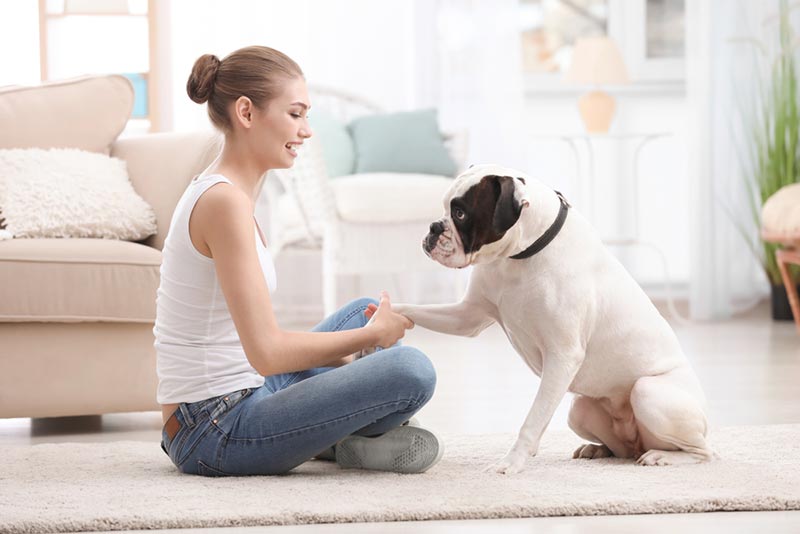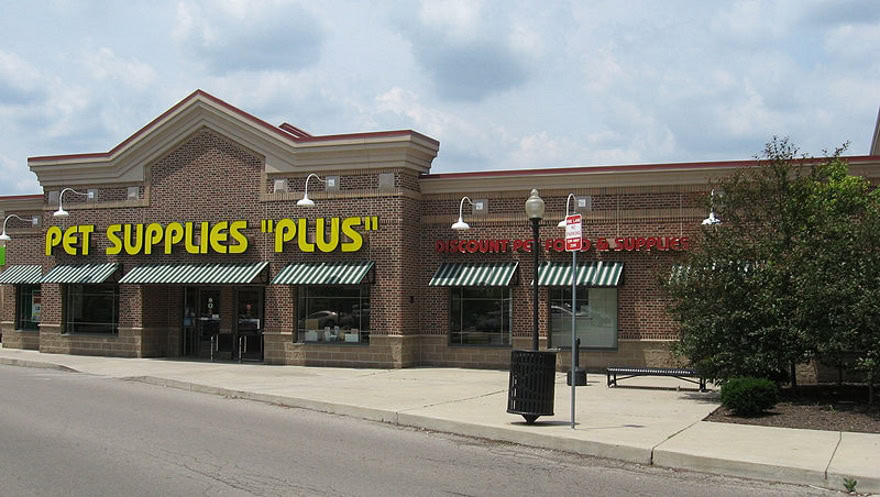VET APPROVED

The information is current and up-to-date in accordance with the latest veterinarian research.
Learn more »Click to Skip Ahead
Owning a dog is a great responsibility and an expensive one, but it doesn’t need to break the bank. How to save money on dog costs is a question that many pet owners ask, particularly when money is tight and you’re looking for budget-friendly ways to take care of your four-legged bestie.
Fortunately, there are plenty of tried-and-tested methods of saving money, even for dog owners. With a few nifty tricks, your expensive dog can be more friendly to your budget.

The 25 Tips on How to Save Money on Your Dog
The 9 Tips For Saving on Dog Supplies
1. Avoid Big Name Stores
There are many recognizable pet stores that are useful for all your pet’s needs. However, dedicated pet stores are generally much more expensive than smaller establishments.
Many dog toys and supplies are sold at regular supermarkets or dollar stores. These locations might not specialize in pet supplies in the same way, but they are often more affordable. You should still make sure the toys that you buy are safe and meet quality standards. Toys should not present a choking hazard or any other risk to your dog. Certain cheaper toys might be cheaply made, too.
Yard sales, flea markets, and thrift stores can be good places to find used dog supplies. Provided that they’re clean and in good condition, there’s no reason that your dog won’t benefit from them.
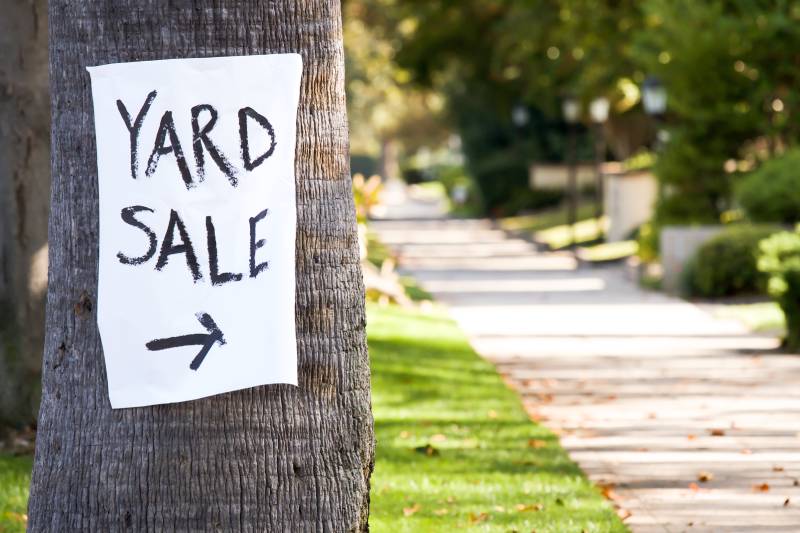
2. Buy in Bulk
It might seem excessive to buy massive dog food bags if you only have one small dog, but in the long run, it can save money. You won’t need to buy multiple small bags at once just to save a trip to the store later in the month. Also, while small bags are lighter and easier to carry, purchasing more of them can end up being more expensive than a single large bag that will last longer.
3. Compare Prices
Shopping around takes time, but it’s also the best way to find the best prices for many things, not just pet supplies. If you do most of your shopping online, you can use a price-comparison tool, or you can window shop at your local supermarkets and pet stores to find the cheapest quality options.
By exploring all the stores available to you, you’re bound to find a few bargains. You might even find affordable dog supplies in places that you weren’t expecting.

4. DIY Your Dog’s Bed
As long as a dog knows that something is theirs, they will find it comfortable, and if it’s close to you, they won’t care whether their bed is homemade instead of brand new and extravagant. If you enjoy making things by hand, test your skills by making supplies for your dog.
DIY dog beds are easy to make, and you can personalize them to suit your dog’s personality or your existing décor. It’s also a great way to upcycle old cushions or crib mattresses that have been stored in your attic for months or that you bought at a yard sale.
5. DIY Your Dog’s Enclosure
Like making a dog bed, you can make an enclosure for your dog too. While it might be easier to buy a ready-made playpen at a store, you can utilize your furniture and the layout of your home to create a safe, out-of-the-way area for your dog.
With planning and careful attention to the mischief that your dog might get into, you’ll be able to safely keep your dog in one place.

6. Make Pet Clothing at Home
During the winter months or rainy, gloomy days, the weather can get uncomfortably cold. If you have a dog that’s prone to feeling chilly, giving them a woolly sweater can make them more comfortable. Perhaps you want your dog to be your partner at your friend’s Halloween party. Either way, if you have experience with a sewing machine, try out DIY pet clothing ideas.
Sewing pet clothing is just like sewing clothes for humans. You need breathable fabric, a sewing pattern that’s designed for dogs, a tape measure, and free time. With the right tools, you can even make a homemade dog collar.
7. Make Dog Treats at Home
There are many recipes online for homemade dog food, but it’s not just the main meal plan that you can supply for your dog. Homemade dog treats can help you affordably cater to your dog’s craving for yummy dog biscuits.
Better still, by following the right recipe and your veterinarian’s advice, you can ensure that the treats are not only nutritious but also tasty and beneficial for your dog. Experiment with several recipes to find the ones that your dog enjoys the most, and keep the recipes handy for your next free day.

8. Research the Best Value Dog Food Brands
If you’re in a rush or are a first-time dog owner, grabbing the first dog food that you see is often the quickest way to avoid lengthy decisions. However, it’s rarely the most cost-effective. You might also assume that spending more on an expensive brand means your dog will be getting the healthiest diet available. Unfortunately, a high price doesn’t always mean high quality.
The best thing that you can do is research dog food brands. With a bit of digging, you’ll see which affordable dog food brands contain high-quality ingredients. You might have to purchase the food online rather than at your local store, but you’ll be saving money in the process.
9. Store Food Properly
When buying food in bulk, you’ll likely need to invest in reliable storage containers. Kibble might be designed to last as long as possible, but once the bag is open, the dry food is susceptible to absorbing the moisture in the air and developing mold. Big bags are also less likely to come with a resealable strip to keep the contents fresh.
Get an airtight container where you can store the kibble. A large bin with a lid in a cool, dry room can keep the kibble fresh for longer. It can also keep it away from mice that you might have hiding in your pantry and prevent your dog or cat from ripping the bag open.
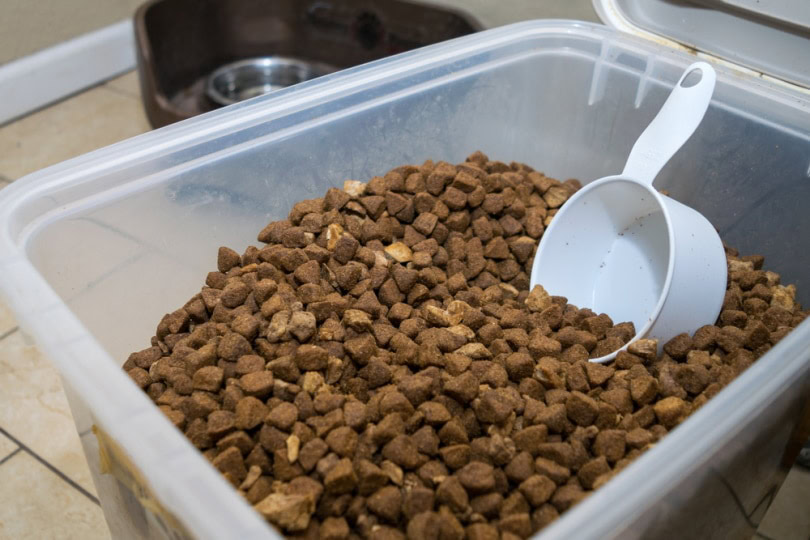

The 5 Tips to Save on General Costs
10. Adopt From a Shelter
If you’ve carefully considered the ongoing costs of owning a dog and decided that you can keep up with their needs, you need to consider where to get your new family member from. Dogs can be purchased from a breeder, given away for free or a small fee, or adopted from a shelter. There’s much to be said about adopting from a shelter instead of the other options.
While breeders offer pedigree dogs that can be registered and may compete in shows, purchasing from a breeder can be costly. Even adopting a dog for free from an individual may come with significant expenses, as the initial veterinary checkups, vaccinations, and preventive care can quickly add up.
In contrast, adopting from a shelter is often the most cost-effective option. You’ll have to pay an adoption fee, but it will cover any spaying or neutering costs, vaccinations, and parasite prevention, making it a financially sensible choice while also giving a dog in need a loving home.
- Related Read: How to Save Money on Vet Bills
11. Find Affordable Boarding Solutions
At some point, you’re probably going to need to board your dog while you’re on a business trip or vacation. Your local kennel might be your first choice because it’s closer, but take the time to consider other kennels in your area, too. You might find a location slightly farther away that’s cheaper while offering the same amenities.
There’s also the option of asking friends, family members, or neighbors you trust to look after your dog while you’re away. They’ll be more likely to be willing to take care of your pet as a favor or in return for a nice meal out somewhere. You’re also likely to feel more comfortable negotiating monetary reimbursement with someone you know, too.
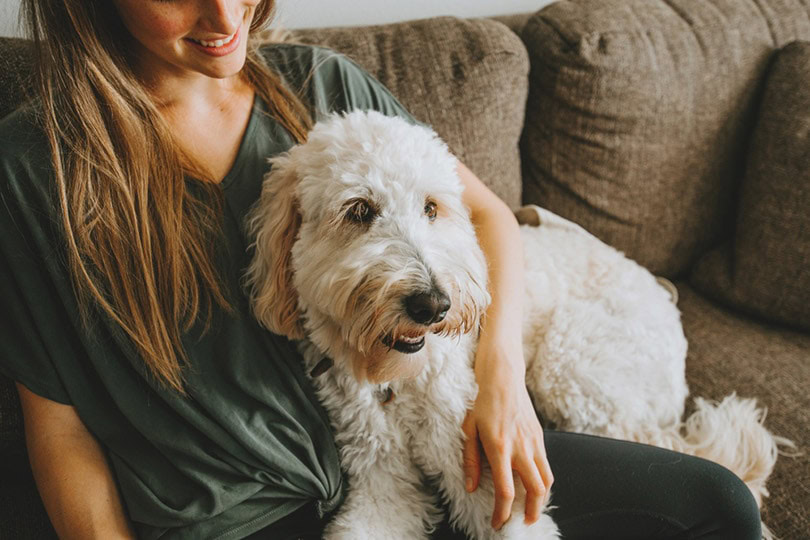
12. Join a Pet Store Loyalty Club
Many local pet stores and other shops have a loyalty program for frequent customers. If you’ve found a store that you like and find yourself visiting frequently, ask if there is a loyalty club that you can join. This will help you save money because you get rewards based on your purchases, such as a discounted or free item once you spend a certain amount.
Not only do physical stores do this, either. Many online stores often have a newsletter that contains promotions such as discount codes, sales, and even giveaways.
13. Train Your Dog Yourself
Teaching your dog how you want them to behave takes a great deal of time and effort, which is one of the reasons that many people don’t bother or just hire a trainer. Obedience training is one of the best ways to prevent costs from damage to furniture or accidents if your dog gets loose while you’re out on a walk. Proper socialization can also help your dog grow into a well-rounded animal that is calm and composed around strangers and other pets.
With the right research, time, and dedication, you can train your dog yourself. Reading books on training, listening to podcasts, and watching videos of professional trainers can help. You can also socialize your puppy yourself by regularly taking them to the dog park or around town.
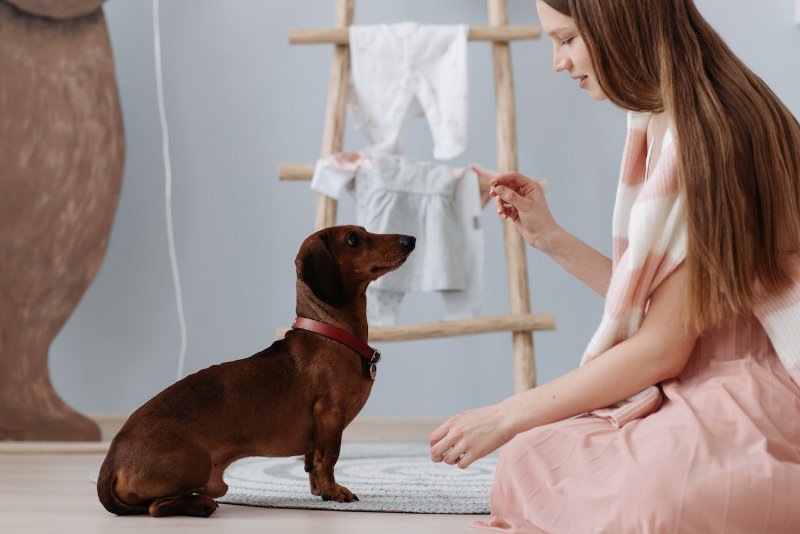
14. Exercise Your Dog Yourself
One of the best parts of owning a dog is that they encourage you to be more active. While it can be simpler to hire somebody else to walk your dog, it’s more cost-effective and beneficial for you if you walk them yourself.
Not only will you and your dog be getting much-needed exercise, but you’ll also be able to fit in playtime at your local dog park. This is a fun way to strengthen the bond between you.

The 3 Tips to Save on Grooming
15. Bathe Your Dog at Home
Unless your dog stinks or gets caked in mud on a rainy day, bathing them shouldn’t be a frequent chore. Too many baths will remove the protective oils from their skin and fur, causing dry skin. Whenever you do bathe your dog, it’s often easily handled at home — even if some dogs dislike the idea of being washed.
Purchase dog shampoo, and keep it for those particularly mucky days when a bath is necessary. You can also invest in a silicone mat that you can fix to the bathroom wall and smear with your dog’s favorite, gooey treat to keep them distracted while you wash them. Remember to avoid getting soap in their eyes and ears, and keep a fluffy towel handy to dry them off.
Giving your pet a bath can be a difficult task, but the first step is to choose a great shampoo. We love Hepper's Shampoo Products, both of which are natural, pet-safe options specially formulated to clean your pet's skin and coat without causing irritation. Both formulas are also free of things like dyes, soaps, sulfates, and phthalates. Your pet will enjoy the soothing aloe vera and oatmeal, and you'll love the clean, fresh scents!
| Image | Product | Details | |
|---|---|---|---|
For Bathing
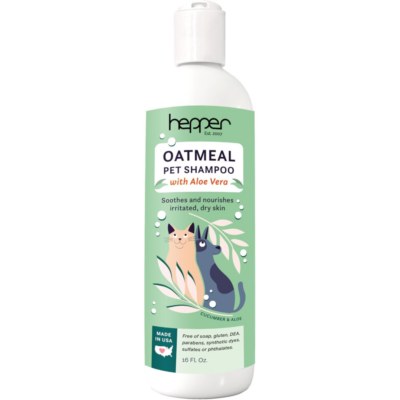 |
Hepper Oatmeal Pet Shampoo |
|
Check Price |
For In-Between Baths
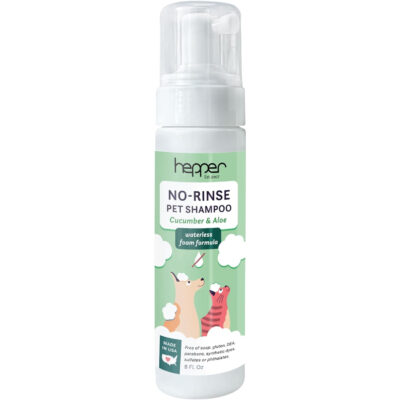 |
Hepper No-Rinse Pet Shampoo |
|
Check Price |
At PangoVet, we've admired Hepper for many years, and decided to take a controlling ownership interest so that we could benefit from the outstanding designs of this cool cat company!
16. Brush Your Dog at Home
Grabbing a brush and grooming your dog is perhaps one of the easiest — albeit time-consuming — tasks that you can do. It’s a habit that you should get into as early as possible so your dog gets used to the routine. You can help manage their shedding and keep their fur smooth, sleek, and healthy.
While you can find affordable groomers who will do the work for you, in the long run, even less-expensive professionals can get costly, especially when you can just groom your dog at home. All you need is a brush suited to their fur type and a few spare minutes to run it through your dog’s fur. Even if you brush them while watching TV, your dog will enjoy the attention, and it’ll relax you too.
17. Learn How to Trim Your Dog’s Nails
Unlike the other parts of a dog’s grooming routine, trimming their nails is a task that most dog owners loathe — not because it’s hard work but because of the fear of causing pain by accidentally cutting the quick. When it comes to cutting nails, many dog owners prefer to pay a professional groomer to do it instead, particularly if the dog has dark nails and the quick isn’t visible.
As always, though, the cheaper option is to do it yourself. Unfortunately, it’s not a task that you can avoid, as too long claws can cause your dog pain as they walk.
If you’re nervous about trimming their nails, especially if they’re long, take it slow and only snip a little at a time. It’ll take longer, but you’ll reduce the risk of accidentally cutting the quick.
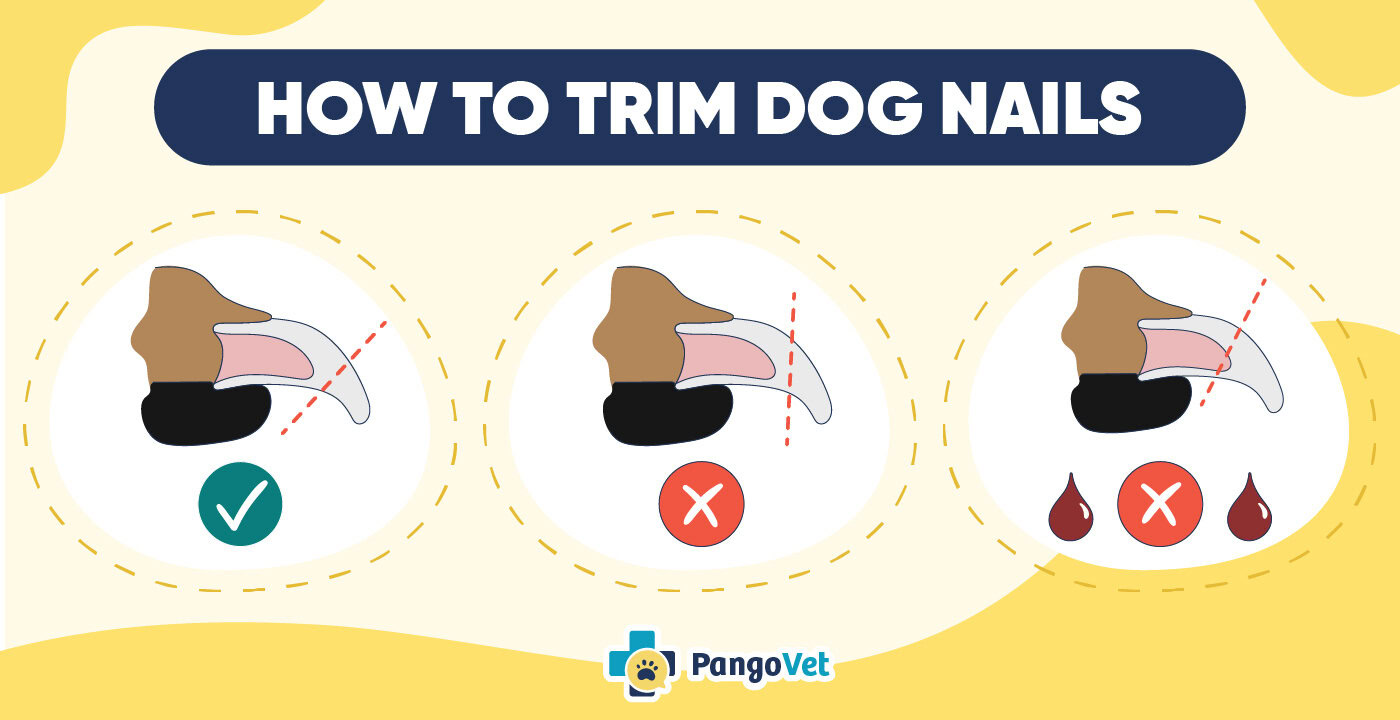

The 8 Tips for Saving on Veterinary Care
18. Decide Whether Pet Insurance Is Right for You
Dogs can get into all sorts of mischief, and their adventures can lead to unexpected accidents. They can also develop illnesses as they age. Either can cost a small fortune at a veterinary clinic to properly diagnose and treat. Pet insurance helps offset the cost by reimbursing a certain amount of the vet bill.
While it’s becoming more popular and can help reduce the cost of emergency vet bills, pet insurance isn’t a choice that every pet owner is happy with. If you can’t afford the monthly fee, for example, or there isn’t a policy that covers your senior dog, pet insurance might not be the right choice. You need to consider your needs and your dog’s age and medical history before deciding.
19. Don’t Overpay for Medication
Alongside veterinary bills, the cost of medication can be a problem. If your dog has a chronic condition and needs ongoing prescription medication, those costs add up. The first place that you think of to buy the medication that you need isn’t always the cheapest.
Shop around for local, family-owned pet stores or other pharmacies that might carry the medication at a lower cost than your veterinary clinic. You can also purchase medication online and take advantage of coupons and other discounts.
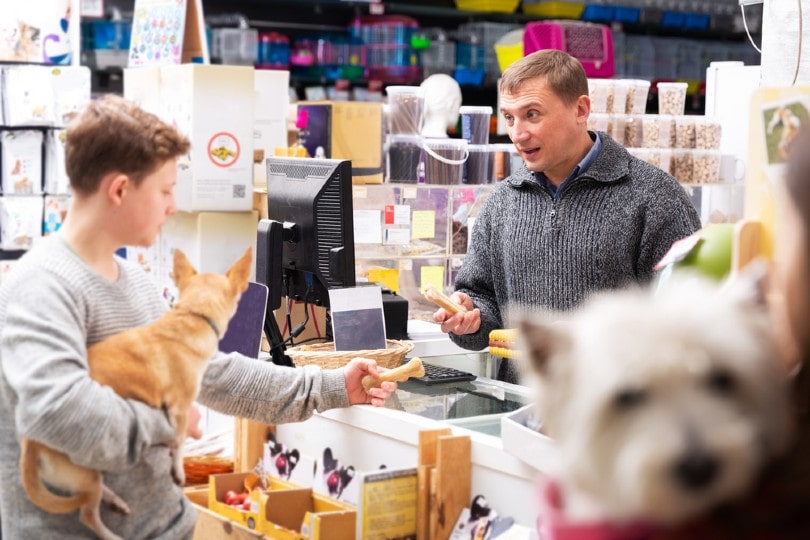
20. Keep a Doggy First Aid Kit
Not all injuries need to be tended to by a veterinarian. Some incidents, like accidentally cutting the quick when you trim your dog’s nails, can be handled at home. Keeping a first aid kit designed for your dog is one of the best ways to prepare for any of these minor eventualities. For example, in the case of a bleeding quick, styptic powder or even cornstarch is a reliable way to stop the bleeding.
There are times when a trip to the vet is unavoidable, though. If your dog’s wounds are bleeding, visiting a veterinarian is necessary.
21. Use Veterinary Telehealth Services
Another good option that will save you money and time is a veterinary telehealth service like we offer here at PangoVet. If you have questions about your dog’s health, experienced veterinarians can answer them in a one-on-one video chat from the comfort of your couch. Telehealth vets can help you understand a diagnosis, work through behavioral problems, decide whether a trip to your vet is necessary, and much more. Though these services typically don’t provide prescriptions and can’t replace in-person vet check-ups, they can help you make informed decisions about your dog’s health while keeping costs down.
22. Make a Doggy Savings Account
Although pet insurance is often recommended if you want to save money, it’s not the only way to lower costs. You can make your own insurance by creating a savings account for your dog.
Similar to a college fund for a child, you can make a separate savings account and set aside funds every month for the duration of your dog’s lifetime. The idea is that by the time you may need to pay an emergency vet bill, you’ll have more than enough saved to cover the cost, and it won’t break the bank to do so.

23. Regularly Brush Your Dog’s Teeth
Many problems can arise when you skip out on dental care, and the same goes for dogs. With all the scrumptious treats and illicit table scraps that dogs eat, their teeth can suffer from various dental issues. A lack of proper dental care can result in bad breath, but also gingivitis and periodontal disease.
Treats designed to clean teeth are helpful, but not as effective as a reliable doggy toothbrush and paste. Never use human toothpaste, as it can contain ingredients that are toxic to dogs.
Brushing your dog’s teeth daily and getting them accustomed to it from an early age is a great way to maintain their dental health and prevent costly treatments for more serious issues.
24. Spay or Neuter Your Dog
Dogs are expensive as it is, but if your female dog has puppies, you’ll have to pay for their care too, along with any advertising for new homes, vaccinations, and veterinary visits. If you adopt your dog from a shelter, the cost of spaying or neutering is already covered because many shelters will spay/neuter the animals that they take in if it hasn’t already been done.
You can often find shelters or rescues that offer cheaper rates for the surgery to help prevent pet overpopulation.
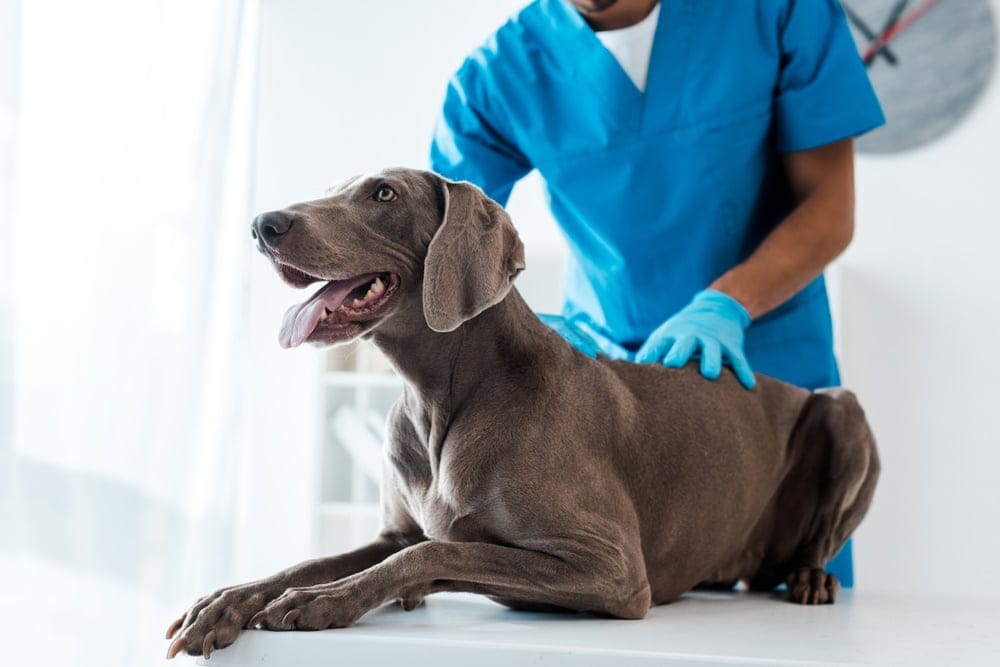
25. Prioritize Preventive Vet Care
Keeping your dog healthy is one of the best ways to avoid costly emergency vet visits. Staying up to date on vaccines and parasite control helps protect them from certain preventable illnesses like parvovirus, distemper, Rocky Mountain spotted fever, and Lyme disease. Investing in preventive care now can save you from expensive treatments later and keep your pup feeling their best.
Visiting the vet for routine checkups can also help you catch health issues before they become serious problems. The earlier they are diagnosed, the easier it is to prevent or treat them. It still might cost money, but it’ll be cheaper than the full expense of delayed treatment.

Conclusion
Dogs take a significant amount of time, dedication, and money to ensure that they’re as happy as possible. Most of the costs can be lowered with a few careful adjustments to your budget, though. Whether it’s making their bed out of an old crib mattress or learning how to groom and clip their nails yourself, many expenses can be cut out of your budget almost entirely.
Featured Image Credit: Africa Studio, Shutterstock
